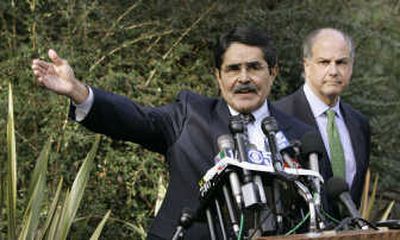Criticism of zoo’s director heats up

SAN FRANCISCO – Since the deadly tiger escape at the San Francisco Zoo, its director has come under increasing criticism over his track record and his suggestion that the victims brought the attack on themselves by taunting the animal.
The lawyer for two of the visitors mauled in the Christmas Day attack is threatening a defamation lawsuit over what he claims is a despicable blame-the-victim strategy on the part of the zoo, and animal rights activists have long accused zoo Director Manuel Mollinedo of putting too much emphasis on showmanship.
“We’ve asked for his termination,” said Elliot Katz, president of In Defense of Animals.
So far, the American Zoo and Aquarium Association, which accredits the nation’s zoos, and the zoo’s overseers are standing by Mollinedo.
“Since Manuel joined us in 2004, the zoo is in better physical and financial shape than it’s ever been,” said Nick Podell, president of the San Francisco Zoological Society.
Before coming to San Francisco, Mollinedo was widely praised for his work at the long-neglected Los Angeles Zoo, even though a dozen animals slipped out of their enclosures during the course of a year.
In the San Francisco Zoo attack, the 350-pound Siberian tiger apparently jumped over a 12 1/2-foot wall around its pen and killed 17-year-old Carlos Sousa Jr.
His friends, brothers Kulbir Dhaliwal, 23, and Paul Dhaliwal, 19, were mauled.
The zoo’s initial response to the attack seemed confused and disorganized. Police radio transcripts reveal that zoo employees initially questioned whether early reports of the attack were coming from a mentally unstable person.
When questioned by reporters, Mollinedo gave an inaccurate figure for the wall’s height, putting it at 18 feet.
Then, two days after the attack, he acknowledged the wall was only 12 1/2 feet – or 4 feet below the recommended national standard.
Several days after the mauling, the zoo hired Sam Singer, a prominent San Francisco crisis-management specialist. Acknowledging that the zoo had bungled its initial response, Singer adopted a new strategy.
Soon, the public and the media’s attention turned from the competence of zoo officials and the substandard tiger exhibit to the victims’ behavior before the escape.
At a news conference, Mollinedo suggested “something happened to provoke that tiger to leap out of her exhibit.”
A rash of false information soon emerged in the media, including reports that the victims had slingshots and had been drinking near the zoo.
Singer admitted Tuesday that he told reporters about the slingshot rumor.
Mark Geragos, the lawyer for the mauled survivors of the tiger attack, lambasted Singer’s tactics as “an abomination” and threatened to sue for defamation.
“To be attacked by a tiger, number one, then to be attacked viciously by false and defamatory stuff is too much,” Geragos said.